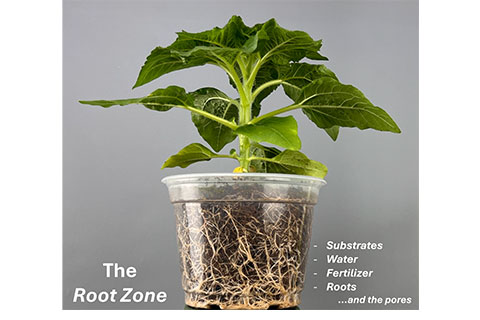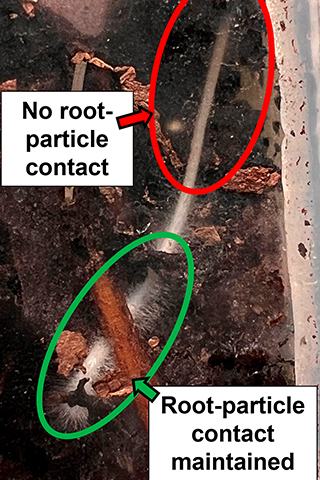7/31/2025
Through the Pores
Jeb S. Fields & Kristopher S. Criscione

There’s a hidden dimension behind the container wall beyond what’s easily visible to the grower. It’s the middle ground between particles and pores, between water and air. This dimension ranges container depths and volumes, and its influence on plant growth and sustainability can be sizable.
“The Root Zone.” All the action happens here.
This is the zone where roots navigate, branching into the pores. It’s an area we call “The Root Zone.” Unlike in the soil, the root zone consists of essentially the container volume. So, in all reality, the root zone includes mostly everything that growers are managing in production (substrate, irrigation, fertility, etc.).
Pore Science III: Roots in motion
Roots explore their environment, seeking resources needed to sustain growth. Like how our brains convert stimuli from sensory organs to make decisions, the root tip perceives the container environment and controls overall root growth. A root system can be quite extensive and complex. Despite this complexity, the culmination of an entire root system begins with the initial actions of thousands of individual root tips.
We learned in the previous articles how physical and chemical properties of soilless substrates are different than mineral soils. These key differences redirect root tips and change their development. As the root tip elongates through the pore and particle structure, it continuously interprets the local root zone conditions, sensing gravity, moisture, nutrients and particle obstacles. This occurs mainly through feedback of plant hormones, which is a common response to physical contact with particles or chemical interactions with fertilizer salts, substrate chemicals, or microbes and insects.
Since soilless substrates are primarily pores (often >80% porosity), root tips will either grow along or inside a particle, expand into an existing pore or establish unique root-derived pore paths. A pore only has so much volume, so when a root tip grows into an existing pore, it can essentially “clog” the pore, resulting in decreased pore volume or generate a series of smaller pores. This can alter the pore distribution of the substrate and lead to increased water-holding capacity due to reduced average pore sizes. This is important to consider when a plug liner is initially transplanted and starting to establish its root system. The roots may not be filling the pores right away, but as they grow, they change their substrate environment and can alter later irrigation decisions.
 As the root system continues to explore the root zone, several possibilities may occur. Larger lateral roots can redirect infiltrating irrigation water, which can result in more preferential flow and increased drainage rates. This is problematic since when we have a large plant full of roots, we need to make sure water is available! Even a highly rooted substrate, as in the case with root-bound containers, may disrupt downward water flow and can ultimately reduce drainage. These effects aren’t necessarily linear or black and white. Rather, they’re dependent on the plant species, substrate used and length of time.
As the root system continues to explore the root zone, several possibilities may occur. Larger lateral roots can redirect infiltrating irrigation water, which can result in more preferential flow and increased drainage rates. This is problematic since when we have a large plant full of roots, we need to make sure water is available! Even a highly rooted substrate, as in the case with root-bound containers, may disrupt downward water flow and can ultimately reduce drainage. These effects aren’t necessarily linear or black and white. Rather, they’re dependent on the plant species, substrate used and length of time.
When the root does not have strong particle contact, it can withhold lateral roots or root hairs from forming. This is to protect itself from drying until the root can find particle contact.
It’s inside the pore where the root tip preferences influence root architecture. If the pore is too large and filled with air, hormones that inhibit lateral roots and root hair initiation will accumulate until contact with particles or moisture is made. In smaller pores, this often doesn’t happen and roots are stimulated to continue branching due to more moisture availability.
When root tips elongate, cells divide and create an outward pressure, pushing particles out of the way. Have you ever seen a road or sidewalk broken or lifted by tree roots? Roots can generate a great deal of power. However, while capable of mustering great force, roots will almost always choose the path of least resistance, where smaller substrate particles are typically easier for proliferating roots to grow through.
Fine particles will usually result in the development of fine (thin) roots, which are responsible for water and mineral nutrient uptake. Thus, with a fibrous and “feeder” root system, better water-use efficiency and nutrient absorption can be achieved. Roots prefer a snug environment, where these smaller pores and particles also promote better root-substrate contact, which is incredibly important in the root developing properly. Be careful—too fine a substrate can decrease the amount of available oxygen and harm the roots.
In the first part of this series, we discussed how pores are connected by neighboring pores. The more complicated these pore pathways, a term we call “tortuosity,” the more complex the substrate labyrinth is for growing roots. At first glance we may think that intricate pore pathways can result in an expansive root system. However, this is far from the truth. Yes, the roots have more unique opportunities to branch and explore the pores, though this is costly for the plant. Roots instead tend to proliferate more efficiently in substrates that have better pore uniformity (i.e., pores have similar sizes). This encourages straighter and continuous root pathways than a complicated or tortuous path. Finer substrates usually have a more uniform particle (and pore) distribution. This enables root tips to continuously elongate, without interruption, and ultimately use less energy to grow in straighter paths.
It can also be expensive (resource-wise) for the root to penetrate through some obstructive particles. When root tips are elongating through large particles, such as large flat bark particles or coarse perlite, roots must invest resources (carbon, water, energy) to forcefully move the particle or grow around their obstruction. This not only takes added time, but it can decrease the productivity of the root.
Selecting the best substrate can be difficult. From optimizing drainage and water storage characteristics to managing cost and availability, selecting a substrate that promotes stronger root development is paramount. There are many options to choose from, so how can we improve containerized root growth though substrate practices? Find substrates that help stimulate root-substrate contact, like finer sizes of pine bark or adding an amendment to bark mixes, to help improve particle and pore connectivity for outdoor nursery production.
We hope that your knowledge of pore science and confidence in managing substrate spaces has grown as you read these articles. The substrate pore matrix is not only complex, but is incredibly dynamic, changing regularly. The beautiful or unifying fact of pore science is that it’s all connected in “The Root Zone.” Like the old adage, “Every cog in the machine has its role,” every part—whether it’s water, solutes or roots—plays a part in changing pore properties. The collective alterations of these pores can be related to past production decisions and even inform future ones. It’s certainly difficult to gauge how spacious your potting soil is simply by visualizing; however, proper management of the pores can be the difference between profitable yields and wasteful water or fertilizer applications. So next time you fill a container with substrates or purchase potting soil, stop and think: “I’m managing spaces.” GT
Kristopher Criscione (kscriscione@vt.edu) is a Nursery Specialist with Virginia Tech. Jeb Fields (jsfields@ufl.edu) is a Nursery Specialist with the University of Florida and the editor-at-large for Nursery & Landscape Insider, a Ball Publishing enewsletter. Together, their work revolves around understanding and improving root zone management in plant production.